France: A Lot to see in sunshine


Usually a week in France, out of the school holidays, is a relaxing affair. Warm sunshine and endless blue sky days might just make you feel a little guilty. Not this time, not after the effort it took to get there.
The day we were pointing the car south to catch the ferry, the heavens opened. Motorways were blocked, side roads flooded and all the places ‘Sally Traffic’ mentioned to avoid, were just where we were going. When for the first three hours, the average speed was below 30mph we did think about abandoning our venture. However, we persisted and eventually reached the sanctuary of the cross channel ferry and fell into the cabin exhausted.
Advertisement
Hide AdAdvertisement
Hide AdAfter a good night’s sleep we headed south for another eight hours on the road, the first two in a familiar and depressing environment, rain. Stopping for supplies and the odd ‘power nap’ we eventually stepped out of the car to be greeted by our smiling gite owners in the Lot area of south-western France, tired but with a sense of achievement. It was warm and dry, perfect.


The small villages in the Lot that edge onto the area’s rivers and cling to the vertical limestone cliffs are built in stone reflecting the colour of wheat being harvested in the fields. Some are outstandingly beautiful and deserve time spent ambling around looking for restaurants hidden from the speedy visitor. Others have houses that defy gravity as they launch skywards, using the rock face as a rear wall.
We had no particular plan and let the week unravel in front of us; the major decision of the day was whether to turn right or left out of the gite. After that we just followed the road to whatever visual feast lay ahead, be it the brightly coloured market stalls of Limogne-en Quercy or the foreboding Chateau Bonaguil, each equally as photogenic as the other.
Roads hug the edge of the valley floor and you drive in between a rock and a wet place. One side is the perpendicular cliff, the other, the river. It’s an advantage to be in a right hand side drive vehicle as you can judge exactly how far you are away from bending metal and spoiling your holiday.
Advertisement
Hide AdAdvertisement
Hide AdNarrow, single track bridges allow passage over the rivers and there’s no time for a glance down, concentration is needed at all times. Climb away from the valley floor and the effort is rewarded with panoramic views over the countryside.
Vineyards seem to flow in green waves sharing the earth with wheat fields as they stretch out into the distance only hemmed in by the lazy River Lot winding its magisterial way through the landscape. The tiny village of Belaye offers such a viewpoint and the day we visited we had it to ourselves, drinking in the view in total peace and quiet.
Eventually country roads turn into urban ones and we visited a couple of larger towns. The old town of Cahors is a warren of tiny streets and squares. In the heart of the city, built in a defensive position surrounded by the River Lot, office and shop workers lunch outside as they recharge their batteries. It wasn’t too hard to join them. I know it’s a lot to do with the weather but how refreshing is it to see people enjoying themselves over a lunch eaten out of doors. No grabbed sandwiches and coffee eaten at your desk here, and the boss is on the next table.
The most attractive bridge in Cahors is Pont Valentre. Originally built as a medieval stand alone fort to guard the river it is now one of the city’s most popular tourist attractions as visitors amble across its arches to walk under the towers.
Advertisement
Hide AdAdvertisement
Hide AdAnother town with easy access and easy walking is Figeac. Set on the north bank of the River Cele Figeac prospered in the Middle Ages through commerce and this is reflected in the restored medieval sandstone townhouses, complete with an open air top floor ‘soleilho’, used to dry food , laundry and goods. The narrow streets of old towns in France are not suitable for motor traffic and pedestrians can take advantage of the lack of cars.
For a change of pace we let the train take the strain. The tourist train, based at Martel, is an hour long trip to St Denis above the Dordogne Valley with a couple of stops for passengers to stretch their legs and take pictures.
A small steam loco pulled our open air carriages up and down the line and there was some English commentary along the way from the happy train staff. In peak times make sure you get there early enough to park up.
The land is governed by rivers, both on the surface and underground. A visit to the area is not complete without a trip to see caves. Not the wine variety, the geological sort. However, the wine variety is worth a visit with Cahors wine being a particularly pleasant drop.
Advertisement
Hide AdAdvertisement
Hide AdThe caves that we visited, Pech-Merl, had some stunning drawings and rock formations. At just under an hour the trip was not too long and would just about hold the attention span of a teenager, any longer and discouraging sighs will be heard.
Leaving cities and caves behind the area has two must-see places. Both will literally take your breath away – there’s an awful lot of steep streets and steps in both places, Rocamadour and St Cirque- LaPopie.
Rocamadour, one of the most popular places to visit in all of France, is a group of old dwellings that cling to a cliff over the Alzou Canyon, dominated by a castle. It’s probably best to leave the car well outside the town and make your own pilgrimage to the centre. It can be a long walk so be prepared to spend a few hours on the visit.
St Cirque-LaPopie stands high above the River Lot and was once a centre for craftsmen in the middle ages. A climb to the top of the ruined castle, from where the village descends, is worth the effort with views over the river and surrounding countryside the result.
Advertisement
Hide AdAdvertisement
Hide AdThe old village comprises of narrow, steep streets and the tourist will find shops and restaurants to make their stay even longer. Park at either the top or the bottom of village, it’s up to you whether you want to walk uphill or downhill back to your car.
Saturday approached and we had to head north back to the ferry ports. It was Bastille Day and the French were on the move south to sunshine. We, on the other hand, were heading back to rain.